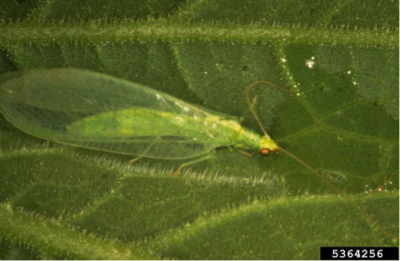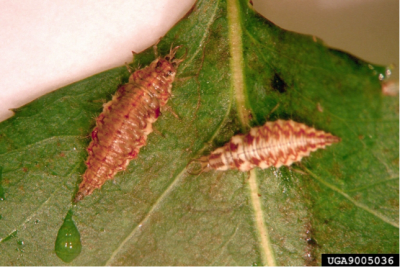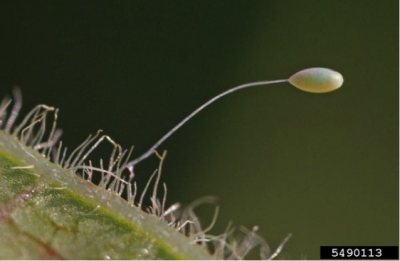By: Donna Ellis, UConn, Department of Plant Science and Landscape Architecture, 2016.

Lacewings are beneficial insects that love to eat aphids, thrips, beetles, small caterpillars, and soft scales. They play an integral role in agricultural pest control, from small backyard gardens to extensive farms. Lacewings are part of the insect order Neuroptera. All immature insects in this order are predators of other insects. Lacewing adults are 8 to 25 mm long, have delicate clear wings with many veins, and at rest they hold their wings over their body. Most lacewing adults feed only on pollen, nectar, and honeydew, but one type of green lacewing will feed on small insects as an adult. There are many different types of lacewings, separated into two larger groups of green and brown lacewings.
One of the most fascinating facts about green lacewings is that

females lay their eggs on ½-inch stalks, either individually or in groups. The stalks may help protect one newly-hatched larva from being eaten by another and also reduces the risk that the eggs or developing larvae may be parasitized. Lacewing larvae, the immature stage of the insect, have a pair of strong jaws to capture and feed on their prey. The larvae impale the prey with their muscular jaws and lift it high in the air. Lacewing larvae are brown in color and are sometimes described as resembling tiny alligators. Another name for a green lacewing larva is an ant lion. These insects undergo complete metamorphosis. The larvae spin silken cocoons around plant stems or leaves during the pupal stage. Adults or pre-pupae overwinter depending on the species, with most species overwintering in cocoons and adults emerging in the spring. There may be multiple generations per year.

Did you know that lacewings have well-developed hearing? They can detect predators such as bats from great distances, and they will quickly drop to the ground to avoid being eaten. These beneficial insects also use their bodies to make vibrations and attract mates of the same species.
References
Cranshaw, W. 2004. Garden Insects of North America. Princeton University Press, Princeton, N.J. 656 pp.
Gardiner, M.M. 2015. Good Garden Bugs. Quarry Books, Beverly, MA. 176 pp.
Pfeiffer, D.G. and H.W. Hogmire. Lacewings. Mid-Atlantic Orchard Monitoring Guide, http://www.virginiafruit.ento.vt.edu/lacewings.html.
Pundt, L. 2014. Biological Control of Aphids. UConn Integrated Pest Management (IPM) website IPM Bilogical Control of Aphids.